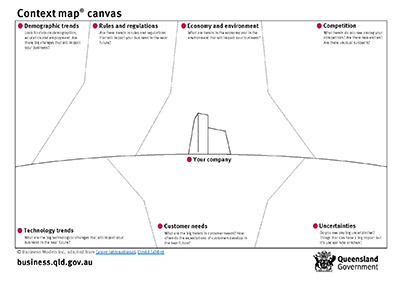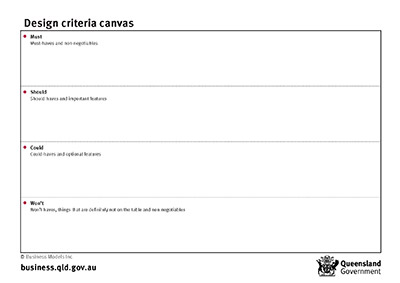Step 2 – Understand how to change
On this page
Turn on this option to focus on essential topics and actions in this step and hide optional parts.
- Understand external change
- Understanding external change – using the context map canvas
- Context map canvas
- Understand internal change
- Understanding internal change – how to manage change you can control
- Update business model canvas
- Understand what matters most
- Design criteria canvas
Understanding change is about being aware of how the world you work in is constantly shifting and adapting. You then need to review how this could affect your business.
It's important to know the context of where and how your business sits within the changing world.
Think of change as a journey:
- Preparing for change determines where you want to go.
- Understanding change identifies how to best get there.
The drivers of change for your business can be:
- internal 'shifts' to your business model
- external 'trends' in the world around your business.
Understand external change
Essential
You must understand and respond to external change for your business to be successful. External trends are often out of your control, but you can control how they affect your business.
Learn to anticipate and develop responses to these external change trends – such as providing a mobile-friendly website to reflect the external trend of customers wanting to shop for your products anytime and anywhere.
You should regularly adjust and develop your business according to trends in the external environment.
The global coronavirus (COVID-19) pandemic provides many examples of external change that affected businesses.
- State and international border closures causing loss of interstate and overseas customers, supply chain and transport issues affecting stock levels.
- Increased health requirements requiring staff retraining and more time spent on cleaning.
- Unexpected lockdowns leading to loss of staff, cash flow issues, loss of stock, customers can’t access products and services.
Other examples of external change:
- Natural disasters causing property and equipment losses, supply chain disruptions and staff not being able to access your premises.
- Increased environmental awareness with customers becoming more interested in sustainable, environmentally-friendly products and services.
- Rapid advances in technology meaning more competition for your business, customers expecting to access your products and services from anywhere, and the risk of products becoming outdated.
- Demographic and social change which changes customer demand for products and services
- Competition in your industry or location leading to a major shift in demand for your products and services.
- Listen to your customers – what are they saying about your products and services? How are their needs changing?
- Talk to your suppliers – are there new materials, products or equipment on offer? What trends are they noticing in the market?
- Keep up with the news – what is happening in your local area, around Australia, and internationally?
- Tap into industry knowledge – what is your industry association or peak body currently researching?
- Monitor your competitors – how are other businesses changing to offer new and improved products and services?
Learn more about market and customer research.
Video - Understanding external change
Watch our video to learn how changes happening in the world around your business can affect your operations.

Complete your context map canvas
The context map canvas will help you:
- expand your thinking beyond your current business model
- understand what's happening in the world around you right now
- learn what changes could affect your business in the near future.
Add a date to your canvas to help you focus on what's happening now, rather than exploring too far into the future.
Download the context map canvas to fill out and save for future reference:
This tool was created by David Sibbet of Grove International, and adapted by Business Models Inc. in the book Design a Better Business (Van Der Pijl, P., Lokitz, J., Solomon, L., Van der Pluijm, E., & Van Lieshout, M. (2016). Wiley.).
Understand internal change
Essential
Internal change is driven by decisions and actions you take in your business. These decisions and changes are something you can control.
Think of internal change as shifts to your business. These shifts could be either:
- immediate change, such as updating technology to improve your operation, or a restructure due to rapid growth or decline in your business
- longer-term change, such as how you respond to changes in customer expectations, attitudes and behaviours, wants, needs and desires.
- Your people – key staff members with valuable skills and experience can be difficult to replace. You may need to take a new direction with recruitment and staff operations, such as re-skilling and training employees, outsourcing tasks or making changes to roles and responsibilities.
- Your property – changes to your business's location or premises to expand your capacity, support new processes or to access new customers and clients.
- Your channels – taking your website from a simple promotional tool for your business to a dedicated sales channel could help you grow your revenue and reach customers who can't visit your premises.
- Your processes and systems – a new piece of equipment or updated technology could have significant benefits for how your business operates. This could be a new customer relationship management system that changes how you interact with your customers, or changes to a manufacturing process which affects your product range or production capacity.
Video - Understanding internal change
Watch our video to learn why it's important to adapt your internal business operations to respond to changes happening in the world around your business.
Identify the right change for your business
Identifying these shifts is key to the performance of your business and your ability to manage change. They'll help you work out how you can provide a more attractive product or service to your customers, and ensure your business stays relevant.
You can identify shifts in your business by revisiting your business model canvas. For example, a shift in your:
- customer segments might help you see new customer opportunities you didn't see before
- customer relationships or channels to the customer can help you better service your customers, or reduce the chances of channels to customers becoming outdated
- value proposition could help you improve your product or services, or reduce the impact of a competitor offering better value
- operations, key resources, key activities or key partners could lower the risk of losing a key partner, or uncover opportunities to improve efficiencies
- financial model, your revenue model or cost model could diversify revenue, or address a threat of costs that might blow out in the future.
These shifts can be small adaptations within your existing business model. They can also be larger, transformational shifts, where bold changes are needed to help your business pivot into a completely new business model.
Revisit your business model canvas
Go back to your business model canvas you completed in step 1.
- Look at the trends you've identified in your context map canvas.
- Work out how these trends affect each of the segments on your business model canvas.
- Update your business model canvas to reflect your new or changing market.
This is where you'll start mapping the changes you want to make to your business. It will help you to understand what internal shifts you'll need to consider to help make the change successful.
Understand what matters most
You've now identified the external trends happening around your business, and what internal shifts you need to consider based on these trends.
Before you start making changes to your operations, you'll need to decide which ones:
- align with the vision you have for your business
- meet the expectations of your customers
- provide the most benefit for your business.
Consider what you must do, should do, could do, and won't do when you're deciding what changes to respond to, and what actions you'll take.
Develop a set of decision criteria that outline what matters most for you and your business using the design criteria canvas. These are the principles and standards behind how you run your business and how you'll approach your response to change.
Must do
- Sustainable and eco-friendly
- Improve staff wellbeing
- Support local suppliers and small businesses
Should do
- Equipment lasts for more than 10 years
- Pricing similar to existing products
Could do
- Integration with existing systems
- Borrow funds or seek new investment
Won't do
- Compromise staff safety
- Products manufactured overseas

Complete your design criteria canvas
The design criteria canvas can help you:
- make better decisions for how you action change
- consider the criteria for making change decisions.
Download the design criteria canvas to fill out and save for future reference:
This tool was created by Business Models Inc in the book Design a Better Business (Van Der Pijl, P., Lokitz, J., Solomon, L., Van der Pluijm, E., & Van Lieshout, M. (2016). Wiley.).
Also consider...
- Learn about ways to measure customer service, including mystery shopping, surveys and feedback forms.
- Find out how to research your market.
- Complete a competitor profile chart to assess your competition.
- Read about creating business values.
- Watch our Lean your business webinar to learn about the 'lean' approach to making continuous improvements, increasing productivity in your business and creating more value for your customers.